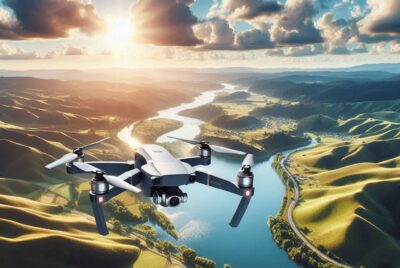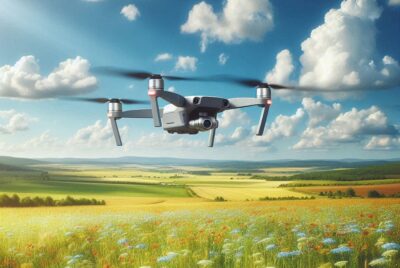Glider Drone: Master the Skies with Precision Flight
*We may earn a commission for purchases made using our links. Please see our disclosure to learn more.
Glider Drone Innovations in Modern Aviation
Glider drones are an interesting part of the drone world. Unlike regular drones, they don’t need engines to stay up in the air. Instead, they use wings and the wind. This makes them quiet and able to fly for longer times without needing power. This can be helpful for people who want to explore remote areas or watch wildlife without making noise.
When thinking about buying a glider drone, keep a few things in mind. The weight and size are important since they affect how long the drone can stay in the air and how far it can glide. You should also think about the materials used in the drone, as this can impact durability and performance. The range and control system are critical too, as they determine how far you can guide the drone.
These aspects are crucial when choosing the right glider drone for your needs. I spent time researching and comparing different glider drones to find the best options for enthusiasts and professionals alike.
Best Glider Drones
I’ve explored some of the top glider drones available today. Each one offers unique features and capabilities.
HAWK’S WORK RC Airplane
The HAWK’S WORK RC Airplane is a fun choice for beginners due to its easy setup and flight controls.
Pros
- Quick to learn with its self-stabilization system.
- Durable foam design that withstands minor crashes.
- Dual battery option extends playtime.
Cons
- Needs wide open spaces to avoid obstacles.
- Rear landing gear can break easily.
- Wind affects performance noticeably.
Flying the HAWK’S WORK RC Airplane felt quite intuitive once I got used to the controls. The included self-stabilization system is a great help, especially for those new to flying drones like me. Its durable foam body also gives me peace of mind during those inevitable crash landings.
This drone is light and zips through the air smoothly, perfect for an open field. I appreciated the dual battery feature for longer flying sessions. Having a backup battery ready lets me enjoy more uninterrupted fun before needing to recharge.
Despite the positives, I did note a few areas for improvement. The rear landing gear is somewhat fragile, which can be frustrating if broken. Also, handling it on windy days was a challenge, so I’d recommend flying this on calmer days to get the best experience. Overall, it’s a solid starter plane with some drawbacks to keep in mind.
Rumdout RC Amphibious Plane
This gadget is a fun pick if you enjoy trying out new flying experiences, with a few quirks along the way.
Pros
- Works well on water and in the air
- Quick to get started
- Well-designed for stability and fun
Cons
- Not super easy for beginners
- Can break with rough use
- Limited controls
The Rumdout RC Amphibious Plane is quite the interesting toy to enjoy both in the air and on water. I loved how it smoothly transitioned and adapted between environments, truly delivering on its promise of dual experience.
The setup was straightforward, and it was ready to go as soon as the batteries were in place, which saved me a lot of time. Its design provides good stability, allowing for more confident flying. Despite its durability claims, I found it might not withstand too many bumps or crashes. This means handling it gently can let you enjoy it longer.
Without a complex control system, it’s not the easiest for complete beginners but still provides decent fun once you get the hang of it. If you’re up for a little challenge and can handle it with care, this plane could be an exciting addition to your RC collection.
Gravity Glider Drone
This drone offers a thrilling flying experience with its powerful engine and thoughtful design features, making it a fun choice for both beginners and seasoned pilots.
Pros
- It’s easy to control even for first-timers.
- The materials are strong but lightweight.
- It can be flown both indoors and outdoors.
Cons
- The range might be limited in larger open areas.
- Some parts may wear out with frequent use.
- Battery life can feel short during longer sessions.
Flying the Gravity Glider feels smooth and steady. Its gyrostabilization system keeps it balanced, so I can enjoy a controlled flight without worrying about sudden dips or turns. The landing gear adds to the ease of landing, making each flight a relaxing experience.
The silicone head is great for peace of mind. If it lands roughly, the drone handles it well. I’ve accidentally knocked it around a bit, yet it has stayed intact. Plus, the fact that it floats is a bonus. Water crashes are less of a concern now.
When I use it inside, its compact size is perfect. I can navigate around furniture with surprising agility. Outside, it handles open skies just as well, giving me enough challenge to keep it interesting. Its versatility makes it a staple for any flying hobbyist.
PANDOUTO Amphibious Glider Drone
The PANDOUTO Amphibious Glider Drone is a fun choice for both water and sky adventures, blending easy control with durable design.
Pros
- Flies and floats due to its amphibious design.
- Beginner-friendly, thanks to its gyro-stabilization system.
- Durable EPP material ensures longevity.
Cons
- Limited to 30 minutes of flight time per charge.
- Not ideal for very young children.
- Foam material can show wear and tear.
Getting started with the PANDOUTO Amphibious Glider Drone was a thrill. I loved how it didn’t just soar above; it also cruised on water. This dual functionality makes it unique and exciting. It’s something I would recommend for those looking to explore different terrains with one device.
Controlling the drone was smoother than I expected. Even though I’m not a seasoned drone flyer, the 6-axis gyro-stabilization really made a difference. It felt stable and manageable, which boosted my confidence in trying out various tricks and maneuvers both in the air and across water surfaces. I imagine kids and adults alike would appreciate its user-friendly nature.
On the flip side, the battery life was a bit of a constraint. Thirty minutes of excitement seemed to pass too quickly. However, having two batteries included helped extend the fun just a little longer. It’s a product that offers plenty of enjoyable moments, though it’s wise to account for charging breaks between flights.
Fortnite Cloudstrike Glider Drone
This drone is a solid choice for any Fortnite fan who wants to see their favorite 4” action figures take flight, but it isn’t without a few issues.
Pros
- Easy to operate with simple controls for takeoff and landing.
- Designed for 4” Fortnite figures, making it great for collectors.
- Offers enjoyable flying experiences with altitude hold and obstacle avoidance features.
Cons
- Sometimes struggles with responsiveness, affecting control.
- Plastic build seems a bit flimsy, potentially impacting durability.
- Occasional pairing issues reported with the remote, which can frustrate users.
Playing around with the Fortnite Cloudstrike Glider Drone was a unique experience. As a Fortnite fan, I appreciated seeing the Skull Trooper in action above my yard. The easy-to-use controls made it simple to operate, which is great for beginners or younger users. Plus, it’s a cool way to integrate physical toys with the virtual world of Fortnite.
However, I noticed that the drone sometimes had trouble responding promptly to the remote controls. This could be due to the wireless technology it’s based on, but it means that controlling the drone might require some patience. The plastic feels a bit light, which doesn’t give the best impression of durability for such a device.
While flying it, the built-in obstacle avoidance sometimes wasn’t as effective as hoped. For younger fans excited to see their action figures soar, the pairing issues with the remote might lead to some initial headaches. Despite these points, it’s still a fun gadget for any dedicated Fortnite collector.
Buying Guide
When I’m looking to buy a glider drone, there are a few key features I focus on. First, battery life is important. I want a drone that stays airborne as long as possible. Some drones have detachable batteries, which makes it easier to extend flight time by swapping out batteries.
Another factor is the range and control. I check how far and high the drone can go and whether it can be controlled from a considerable distance. A reliable remote control with a good connection gives me more flexibility during flight.
Camera quality matters if I’m interested in aerial photography. I look for drones with high-resolution cameras. Some even offer live streaming features, which can be a bonus if I like to see real-time footage.
Weight and portability are also crucial. A lightweight drone is easier to carry, especially if I plan to travel with it. Some models have foldable parts, making them compact and easy to pack.
I also consider the durability of the drone. Drones should withstand minor crashes. Checking for features like protective propeller guards or tough materials helps ensure longevity.
For some, price is a major deciding factor. I usually set a budget and compare features within that range. It’s helpful to read reviews and see what other users think before making my purchase.
Comparison Table
| Feature | What to Look For |
| Battery Life | Long flight duration |
| Range & Control | Good distance, stable remote |
| Camera | High resolution, live feed options |
| Portability | Lightweight, foldable design |
| Durability | Robust build, crash protection |
| Price | Features within budget |
Frequently Asked Questions
When considering glider drones, it’s important to note the differences in cost, features, and functionality. Some glider drones can even be built at home. Let’s explore more about these flying devices.
1. What are the key features to look for in a glider drone with a camera?
I look for a high-resolution camera, long flight time, and strong material. Good stability during flight and easy controls are also important. These features contribute to a better flying experience and quality images.
2. How do the costs of glider drones compare to other types of drones?
Glider drones are generally more affordable than many other drone types. Most have fewer moving parts and simpler designs. I find that this usually leads to lower prices, making them great for beginners.
3. Which models are considered the best glider drones currently available on the market?
Some top models include Parrot Disco and Opterra S+. These offer reliable performance and good cameras. I’ve noticed that many users recommend them for their ease of use and durability.
4. Can a glider drone be built at home, and if so, what are the basic steps?
Building a glider drone at home is possible. I gather materials like lightweight foam, electronics, and a camera. Assembly involves cutting and fitting pieces together, attaching motors and propellers, and connecting the electronics. Many guides are available to help with the process.
5. How does the functionality of UXV drones differ from that of fixed-wing drones?
UXV drones can take off vertically, unlike fixed-wing drones. I notice that while fixed-wing drones require a runway or hand launch, UXV drones work well in confined spaces. This makes them more versatile for different environments and uses.









